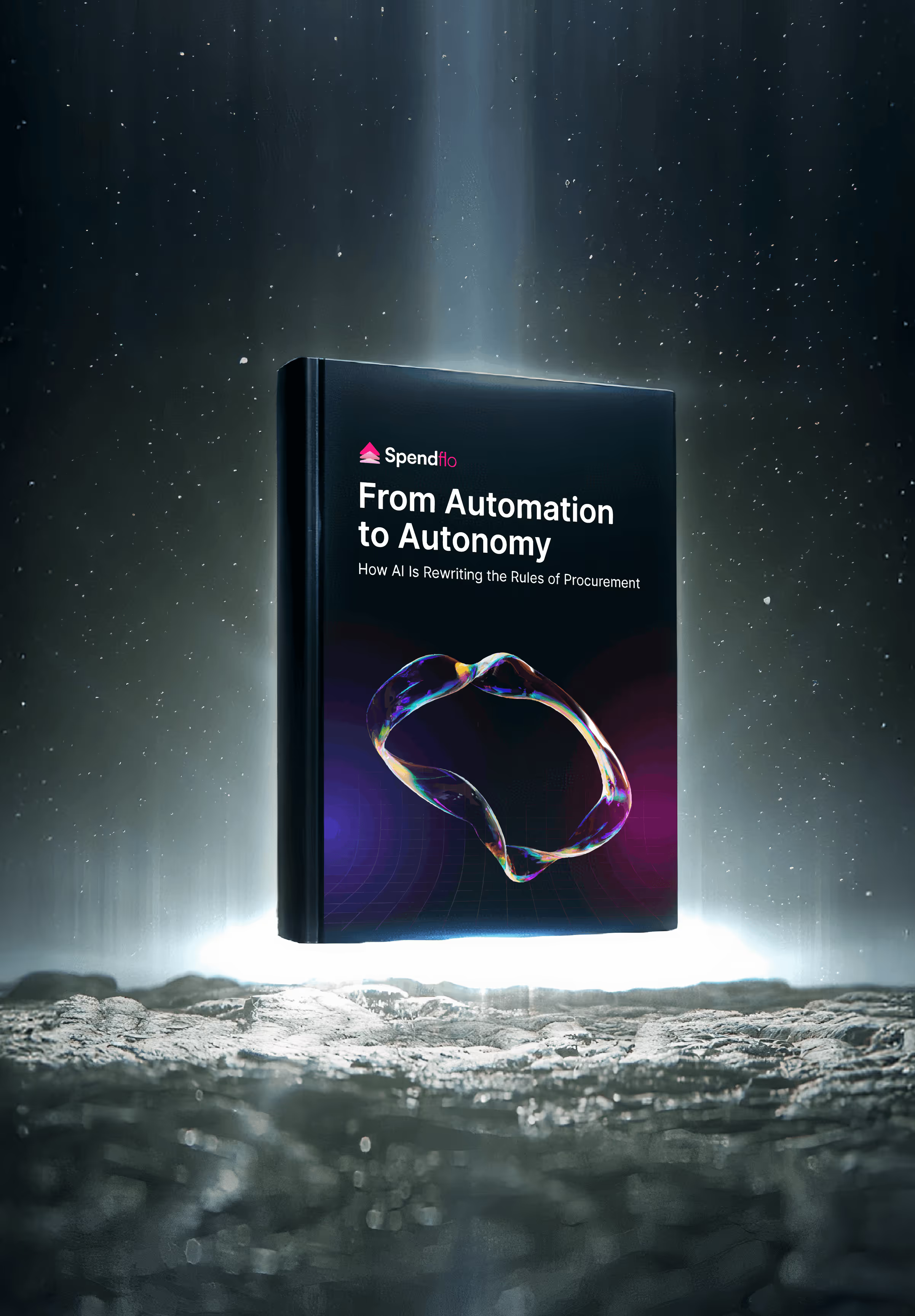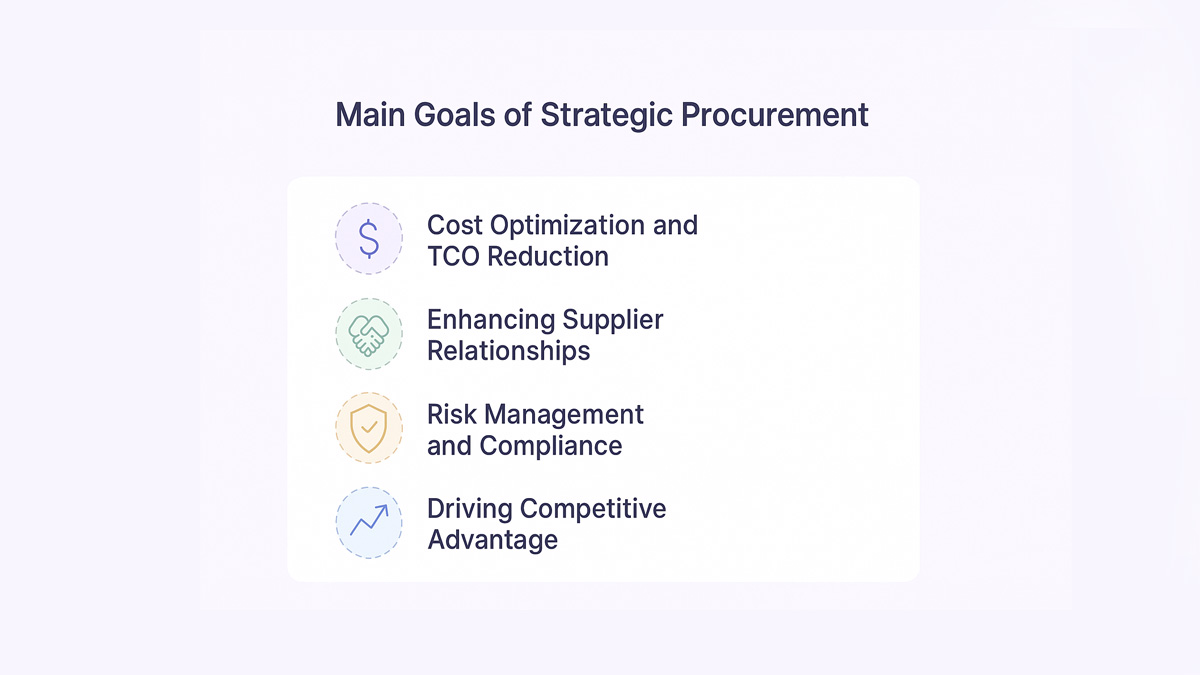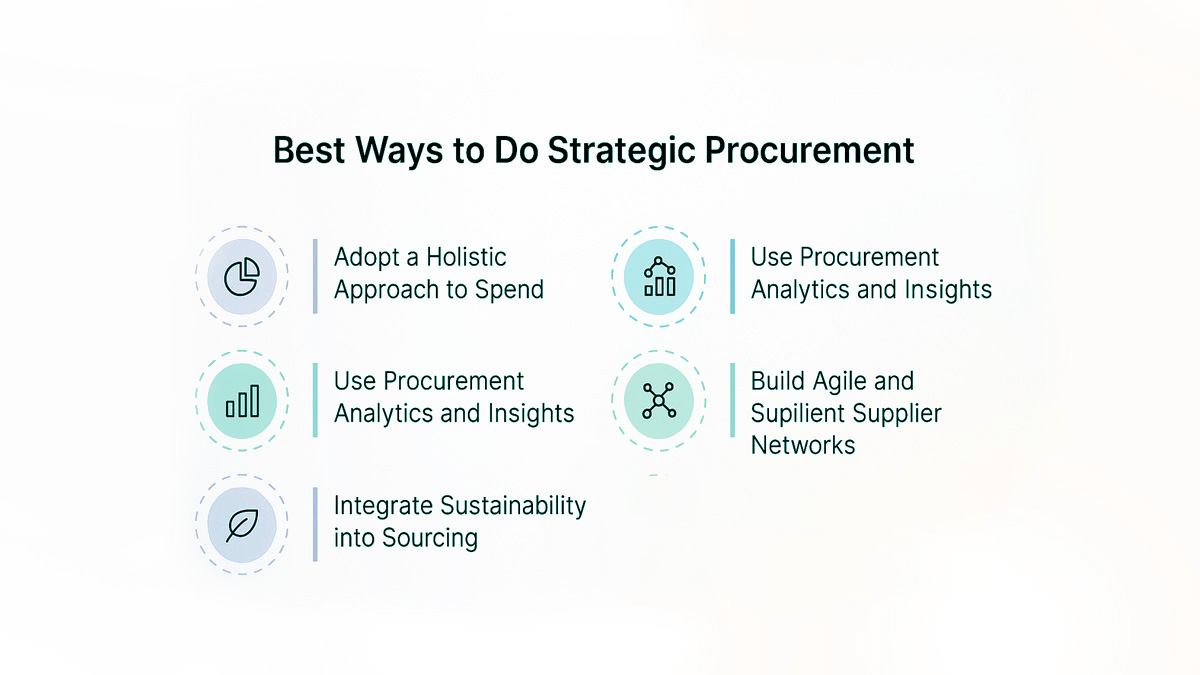

Strategic Procurement: What It Is, Process & Best Practices

Strategic Procurement: What It Is, Process & Best Practices
A complete guide to strategic procurement—its benefits, process, and best practices for cost reduction and resilient supplier relationships.


In a competitive business landscape, organizations can no longer afford to treat procurement as a purely administrative task. The decisions made in procurement directly impact profitability, innovation, risk management, and overall business growth. Strategic procurement transforms purchasing from a cost-saving exercise into a powerful driver of long-term value.
This approach focuses on aligning procurement activities with organizational goals, building strong supplier partnerships, and using data to make informed decisions. It addresses not only what to buy and from whom, but also how those choices affect the organization’s financial health, resilience, and sustainability. A well-defined procurement strategy helps organizations achieve meaningful cost reduction while aligning purchases with long-term business objectives.
What this blog will cover:
- What is strategic procurement
- Why is strategic procurement important
- What are the goals of strategic procurement
- What does strategic procurement include
- Strategic procurement vs. operational procurement
- What is the strategic procurement process
- Best practices for strategic procurement
- How Spendflo helps with strategic procurement
- Frequently asked questions on strategic procurement
What is Strategic Procurement?
Strategic procurement is a long-term, proactive approach to sourcing and supplier management that aligns purchasing decisions with business objectives. It focuses on total cost of ownership, supplier performance, and value creation rather than simply securing the lowest price.
This approach integrates market analysis, category strategy, and supplier collaboration to drive innovation, manage risks, and deliver sustainable competitive advantage. By combining data insights with relationship building, strategic procurement ensures that every purchase contributes to the organization’s success.
Why is Strategic Procurement Important?
Strategic procurement plays a critical role in ensuring that procurement activities contribute to organizational growth and efficiency. It helps organizations anticipate market shifts, manage risks, and secure the resources they need to thrive in changing conditions. This is not just about saving money - it’s about maximizing value over time.
It also provides a framework for aligning procurement with larger corporate priorities, from sustainability goals to product innovation. The result is a procurement function that actively supports the organization’s long-term strategy.
Aligns Procurement with Business Goals
By ensuring that procurement decisions are tied to corporate objectives, organizations can create measurable impact. This alignment bridges the gap between procurement teams and executive leadership, enabling decisions that support revenue growth, market expansion, and operational efficiency.
Enables Long-Term Value Creation
Short-term cost cutting can be damaging if it compromises quality or relationships. Strategic procurement focuses on sustainable value - balancing cost with quality, innovation, and supplier stability - to ensure benefits that extend beyond immediate savings.
Improves Supply Chain Resilience
Proactively managing supplier risks helps organizations withstand disruptions such as market volatility, regulatory changes, or natural disasters. Strategic procurement includes contingency planning, diversification, and stronger supplier partnerships to keep operations running smoothly.
Supports Sustainability and Innovation
By integrating sustainability criteria into sourcing decisions, companies can reduce their environmental impact and meet ESG commitments. Strategic procurement also promotes supplier-led innovation, helping organizations stay ahead in competitive markets.
What Are the Goals of Strategic Procurement?
Strategic procurement has a clear set of goals designed to enhance both financial and operational performance. These goals balance cost savings with value creation, risk savings, value creation, risk control, and innovation. Achieving them requires careful planning, cross-functional collaboration, and ongoing measurement.

Cost Optimization and TCO Reduction
Reducing total cost of ownership means looking at all expenses related to a purchase - from acquisition and maintenance to disposal. This approach uncovers hidden costs and ensures procurement decisions lead to sustainable savings.
Enhancing Supplier Relationships
Strong relationships enable better collaboration, improved service levels, and opportunities for joint innovation. Building trust and maintaining open communication with suppliers leads to higher quality and more reliable performance. Strong supplier relationship management, backed by measurable key performance indicators (KPI), ensures these partnerships deliver consistent value.
Risk Management and Compliance
Identifying and mitigating supplier risks is essential for avoiding disruptions and ensuring compliance with regulations. A strategic approach establishes monitoring systems and contingency plans to handle potential issues before they escalate.
Driving Competitive Advantage
Strategic procurement enables organizations to differentiate themselves through unique supplier partnerships, innovative sourcing methods, and optimized supply chains. This creates market advantages that are difficult for competitors to replicate.
What Does Strategic Procurement Include?
Strategic procurement encompasses a range of activities and processes that together deliver value to the organization. It involves both analytical and relationship-building skills, and its scope extends across the entire supply chain.
Spend Analysis and Category Strategy
Analyzing organizational spend helps identify opportunities for savings, consolidation, and strategic sourcing. Category strategies ensure that each segment of spend is managed in a way that aligns with overall business objectives.
Supplier Selection and Segmentation
Selecting the right suppliers involves evaluating quality, cost, risk, and alignment with company values. Segmentation allows procurement teams to prioritize strategic suppliers while automating or streamlining less critical relationships.
Contract and Performance Management
Effective contracts clearly define expectations, deliverables, and performance measures. Ongoing performance tracking ensures that suppliers meet agreed standards and deliver value throughout the contract term.
Continuous Improvement and Innovation
Strategic procurement is never static. Regular reviews of supplier performance, market conditions, and internal needs help identify areas for improvement and encourage innovation from suppliers.
Strategic Procurement vs. Operational Procurement
While both strategic and operational procurement are essential, they serve different purposes within the organization. Understanding these differences helps ensure that resources and attention are allocated appropriately.
Focus and Scope
Strategic procurement involves long-term planning, category management, and risk mitigation. Operational procurement handles the day-to-day process of ordering and receiving goods and services. Regular supplier evaluation keeps performance high and adapts sourcing strategies to the evolving procurement landscape.
Time Horizon
Strategic procurement looks ahead over years, developing relationships and plans that will serve the organization in the future. Operational procurement focuses on fulfilling immediate needs.
Decision-Making Approach
Strategic procurement is informed by market research, data analysis, and collaboration across departments. Operational procurement follows established processes to ensure timely delivery of goods and services.
Tools and Metrics
Strategic procurement uses advanced analytics, benchmarking, and supplier scorecards. Operational procurement relies on transactional tools such as purchase orders, receipts, and invoice processing systems.
What is the Strategic Procurement Process?
The strategic procurement process is a structured approach to sourcing that maximizes value and minimizes risk. Each step builds on the last to create a comprehensive, repeatable framework for decision-making.
Define Business Needs and Objectives
Start by aligning procurement requirements with the organization’s strategic goals. This ensures every sourcing decision supports broader priorities.
Analyze the Market and Suppliers
Gather data on market trends, supplier capabilities, and potential risks. Understanding the landscape allows you to make informed, competitive sourcing choices.
Develop a Category Strategy
Create tailored strategies for each category of spend that balance cost, quality, and risk. These strategies should also consider sustainability and innovation goals. Incorporating sustainable procurement practices and leveraging a centralized procurement platform strengthens compliance and efficiency.
Negotiate and Contract with Suppliers
Negotiations should secure favorable terms while establishing a foundation for collaboration. Contracts must include clear performance metrics, favorable payment terms, and risk management provisions. Effective contract negotiation secures favorable terms for critical raw materials, reducing the risk of supply interruptions.
Maintain Supplier Relationships
Maintain ongoing communication, performance reviews, and joint planning sessions with suppliers to ensure continuous improvement and innovation. Proactive monitoring of supply risks, combined with robust performance measurement, ensures continuity and operational stability.
Best Practices for Strategic Procurement
Following proven best practices ensures that strategic procurement delivers the maximum possible value. These practices apply to organizations of all sizes and across industries.

Adopt a Holistic Approach to Spend
Consider all aspects of spend, including upstream and downstream processes, to capture the full picture and identify opportunities for improvement.
Use Procurement Analytics and Insights
Data-driven decision-making, supported by detailed data and analytics, allows procurement teams to identify trends, assess risks, and measure performance effectively. Digital transformation, powered by digital procurement tools, accelerates decision-making and improves transparency.
Build Agile and Resilient Supplier Networks
A diversified supplier base can adapt more easily to changes, reducing the impact of disruptions and ensuring continuity. Establishing a clear procurement policy ensures consistent supplier expectations and strengthens compliance across the organization.
Integrate Sustainability into Sourcing
Embedding environmental and social responsibility into procurement practices strengthens brand reputation and meets stakeholder expectations.
How Spendflo Helps with Strategic Procurement
Spendflo simplifies and strengthens strategic procurement by providing a centralized platform for spend visibility, supplier performance tracking, and contract management. This enables organizations to make informed, data-backed decisions quickly and effectively.
By combining technology with expert negotiation services, Spendflo helps companies secure better terms, optimize vendor portfolios, and reduce total cost of ownership. With automated workflows, advanced procurement software, and clear reporting, procurement leaders can focus on strategy while ensuring operational efficiency. Empowered procurement managers can use supplier diversity initiatives to build resilience and open new market opportunities.
Frequently Asked Questions on Strategic Procurement
What is the difference between strategic and tactical procurement?
Strategic procurement is long-term and goal-driven, focusing on supplier relationships and value creation. Tactical procurement addresses immediate, transactional needs.
How can strategic procurement reduce costs?
By focusing on total cost of ownership, consolidating suppliers, and leveraging data for better negotiations, strategic procurement delivers sustainable savings.
Why is supplier collaboration important in strategic procurement?
Collaboration fosters innovation, strengthens relationships, and ensures suppliers are invested in delivering quality and value.
How does data analytics support strategic procurement?
Analytics provide insights into spend patterns, supplier performance, and market trends, enabling better decision-making and proactive risk management.
What are the key risks in implementing a strategic procurement plan?
Risks include supplier disruptions, market volatility, and resistance to change. These can be mitigated through careful planning, clear communication, and stakeholder buy-in.










.png)




.png)










.avif)





